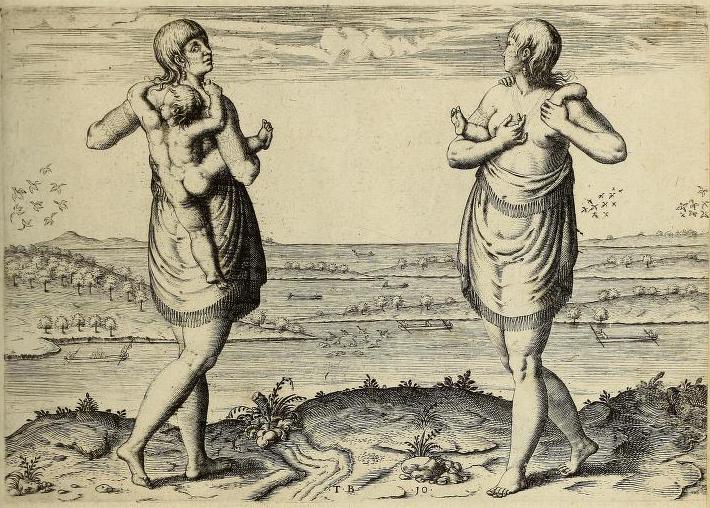Carrying Native-American Babies



Annotation
This watercolor (fig. 1) of a mother carrying her baby was painted c. 1585 by John White who explored the mid-Atlantic region with other Englishmen including Thomas Hariot. Hariot's A Briefe and True Report of the New Found Land of Virginia published in 1590 included an illustration based on White’s watercolor by engraver, Theodore de Bry. (fig. 2)
While John White had painted this Poemiooc mother impossibly carrying her toddler on her back and on her side, De Bry's 1590 engraving included a front and rear view of the same mother. In Beverley's early 18th century version above (fig. 3), there are two different women demonstrating three methods of carrying infants including the cradleboard hanging from a tree between them.
What evidence is there that 16th-century colonizers and 17th-century colonists drew upon artistic traditions and Western cultural values in their depictions of indigenous babies? These visual sources should be used critically, cautiously, comparatively, and corroboratively. What information about Indian children—and those who observed them—can be further gleaned from the 1705 publication that included this description below?
Text
Excerpt from Robert Beverley, The History and Present State of Virginia, In Four Parts, 8–9.
The manner of the Indians treating their young Children is very strange, for instead of keeping them warm, at their first entry into the World, and wrapping them up, with I don't know how many Cloaths, according to our fond custom; the first thing they do, is to dip the Child over Head and Ears in cold Water, and then to bind it naked to a convenient Board, having a hole fitly plac'd for evacuation; but they always put Cotton, Wool, Furr, or other soft thing, for the Body to rest easy on, between the Child and the Board. In this posture they keep it several months, till the Bones begin to harden, the Joynts to knit, and the Limbs to grow strong; and then they let it loose from the Board, suffering it to crawl about, except when they are feeding, or playing with it.
While the Child is thus at the Board, they either lay it flat on its back, or set it leaning on one end, or else hang it up by a string fasten'd to the upper end of the Board for that purpose. The Child and Board being all this while carry'd about together. As our Women undress their Children to clean them and shift their Linnen, so they do theirs to wash and grease them.
The method the Women have of carrying their Children after they are suffer'd to crawl about, is very particular; they carry them at their backs in Summer, taking one Leg of the Child under their Arm, and the Counter Arm of the Child in their Hand over their Shoulder; the other Leg hanging down, and the Child all the while holding fast with its other Hand; but in Winter they carry them in the hollow of their Match-coat at their back, leaving nothing but the Child's Head out, as appears by the Figure.
Credits
John Smith, Watercolor, c. 1585, courtesy British Museum; Thomas Hariot, A Briefe and True Report of the New Found Land of Virginia. New York: J. Sabin & Sons, 1871, courtesy of Documenting the American South, http://docsouth.unc.edu/nc/hariot/hariot.html; Robert Beverley, The History and Present State of Virginia, In Four Parts(London: Printed for R. Parker, MDCCV), 8–9. In Documenting the American South, http://docsouth.unc.edu/southlit/beverley/beverley.html (accessed November 7, 2009). Annotated by Miriam Forman-Brunell.